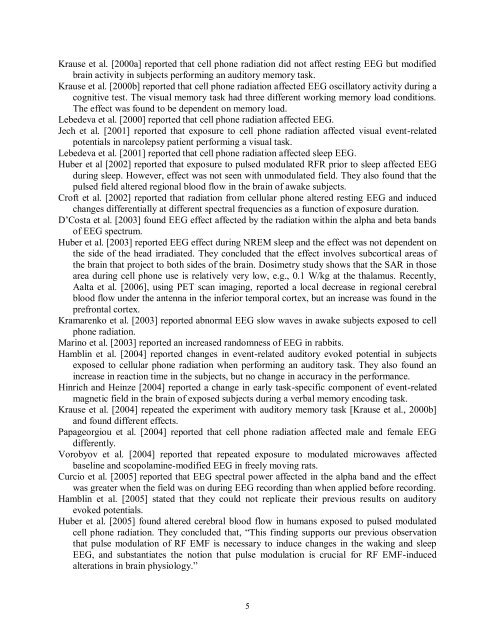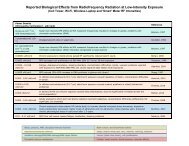Evidence for Effects on Neurology and Behavior - BioInitiative Report
Evidence for Effects on Neurology and Behavior - BioInitiative Report
Evidence for Effects on Neurology and Behavior - BioInitiative Report
Create successful ePaper yourself
Turn your PDF publications into a flip-book with our unique Google optimized e-Paper software.
Krause et al. [2000a] reported that cell ph<strong>on</strong>e radiati<strong>on</strong> did not affect resting EEG but modified<br />
brain activity in subjects per<str<strong>on</strong>g>for</str<strong>on</strong>g>ming an auditory memory task.<br />
Krause et al. [2000b] reported that cell ph<strong>on</strong>e radiati<strong>on</strong> affected EEG oscillatory activity during a<br />
cognitive test. The visual memory task had three different working memory load c<strong>on</strong>diti<strong>on</strong>s.<br />
The effect was found to be dependent <strong>on</strong> memory load.<br />
Lebedeva et al. [2000] reported that cell ph<strong>on</strong>e radiati<strong>on</strong> affected EEG.<br />
Jech et al. [2001] reported that exposure to cell ph<strong>on</strong>e radiati<strong>on</strong> affected visual event-related<br />
potentials in narcolepsy patient per<str<strong>on</strong>g>for</str<strong>on</strong>g>ming a visual task.<br />
Lebedeva et al. [2001] reported that cell ph<strong>on</strong>e radiati<strong>on</strong> affected sleep EEG.<br />
Huber et al [2002] reported that exposure to pulsed modulated RFR prior to sleep affected EEG<br />
during sleep. However, effect was not seen with unmodulated field. They also found that the<br />
pulsed field altered regi<strong>on</strong>al blood flow in the brain of awake subjects.<br />
Croft et al. [2002] reported that radiati<strong>on</strong> from cellular ph<strong>on</strong>e altered resting EEG <strong>and</strong> induced<br />
changes differentially at different spectral frequencies as a functi<strong>on</strong> of exposure durati<strong>on</strong>.<br />
D’Costa et al. [2003] found EEG effect affected by the radiati<strong>on</strong> within the alpha <strong>and</strong> beta b<strong>and</strong>s<br />
of EEG spectrum.<br />
Huber et al. [2003] reported EEG effect during NREM sleep <strong>and</strong> the effect was not dependent <strong>on</strong><br />
the side of the head irradiated. They c<strong>on</strong>cluded that the effect involves subcortical areas of<br />
the brain that project to both sides of the brain. Dosimetry study shows that the SAR in those<br />
area during cell ph<strong>on</strong>e use is relatively very low, e.g., 0.1 W/kg at the thalamus. Recently,<br />
Aalta et al. [2006], using PET scan imaging, reported a local decrease in regi<strong>on</strong>al cerebral<br />
blood flow under the antenna in the inferior temporal cortex, but an increase was found in the<br />
prefr<strong>on</strong>tal cortex.<br />
Kramarenko et al. [2003] reported abnormal EEG slow waves in awake subjects exposed to cell<br />
ph<strong>on</strong>e radiati<strong>on</strong>.<br />
Marino et al. [2003] reported an increased r<strong>and</strong>omness of EEG in rabbits.<br />
Hamblin et al. [2004] reported changes in event-related auditory evoked potential in subjects<br />
exposed to cellular ph<strong>on</strong>e radiati<strong>on</strong> when per<str<strong>on</strong>g>for</str<strong>on</strong>g>ming an auditory task. They also found an<br />
increase in reacti<strong>on</strong> time in the subjects, but no change in accuracy in the per<str<strong>on</strong>g>for</str<strong>on</strong>g>mance.<br />
Hinrich <strong>and</strong> Heinze [2004] reported a change in early task-specific comp<strong>on</strong>ent of event-related<br />
magnetic field in the brain of exposed subjects during a verbal memory encoding task.<br />
Krause et al. [2004] repeated the experiment with auditory memory task [Krause et al., 2000b]<br />
<strong>and</strong> found different effects.<br />
Papageorgiou et al. [2004] reported that cell ph<strong>on</strong>e radiati<strong>on</strong> affected male <strong>and</strong> female EEG<br />
differently.<br />
Vorobyov et al. [2004] reported that repeated exposure to modulated microwaves affected<br />
baseline <strong>and</strong> scopolamine-modified EEG in freely moving rats.<br />
Curcio et al. [2005] reported that EEG spectral power affected in the alpha b<strong>and</strong> <strong>and</strong> the effect<br />
was greater when the field was <strong>on</strong> during EEG recording than when applied be<str<strong>on</strong>g>for</str<strong>on</strong>g>e recording.<br />
Hamblin et al. [2005] stated that they could not replicate their previous results <strong>on</strong> auditory<br />
evoked potentials.<br />
Huber et al. [2005] found altered cerebral blood flow in humans exposed to pulsed modulated<br />
cell ph<strong>on</strong>e radiati<strong>on</strong>. They c<strong>on</strong>cluded that, “This finding supports our previous observati<strong>on</strong><br />
that pulse modulati<strong>on</strong> of RF EMF is necessary to induce changes in the waking <strong>and</strong> sleep<br />
EEG, <strong>and</strong> substantiates the noti<strong>on</strong> that pulse modulati<strong>on</strong> is crucial <str<strong>on</strong>g>for</str<strong>on</strong>g> RF EMF-induced<br />
alterati<strong>on</strong>s in brain physiology.”<br />
5



